The Aesthetics of Utility in Mie: Functional Beauty for Everyday Life
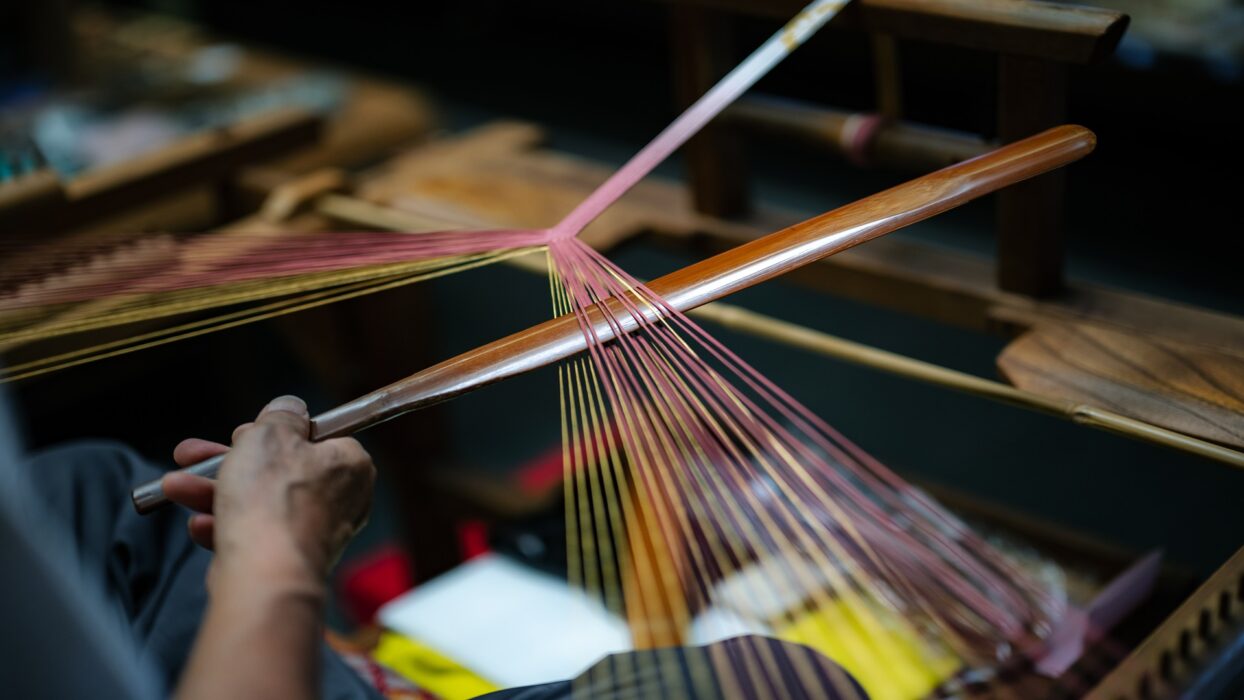
Unlike ornamental art pieces, everyday items exist whose beauty is realized through their continuous use. These are objects of functional beauty, created by artisans who love the materials and consider users. Why not welcome Mie Prefecture’s functional aesthetics, nurtured by rich nature, the skill of local artisans, and those simply living their daily lives with care and attention, into your life today?
- The Spirit of Iki in Miniature: Netsuke, Hidden Gems of the Edo Period
- Casually Enjoying Matsusaka Cotton Kimono at the Utsukushiya/Higashimura Kimono Store
- Upholding a Dyeing Tradition: Discover the Legacy of Ise Katagami at the Suzuka Municipal Museum of Traditional Arts and Crafts
- Weaving toward Future Generations with Iga Kumihimo at Hirosawa Tokusaburo Kumihimo Workshop
- Nagatani-en’s Iga Ware, Treasured by Professional Chefs
- Suigetsu Toen’s Banko-Ware Ceramics: Mild, Well-Rounded Tea with the Shidei Kyusu Teapot
- Access to Mie Prefecture
The Spirit of Iki in Miniature: Netsuke, Hidden Gems of the Edo Period
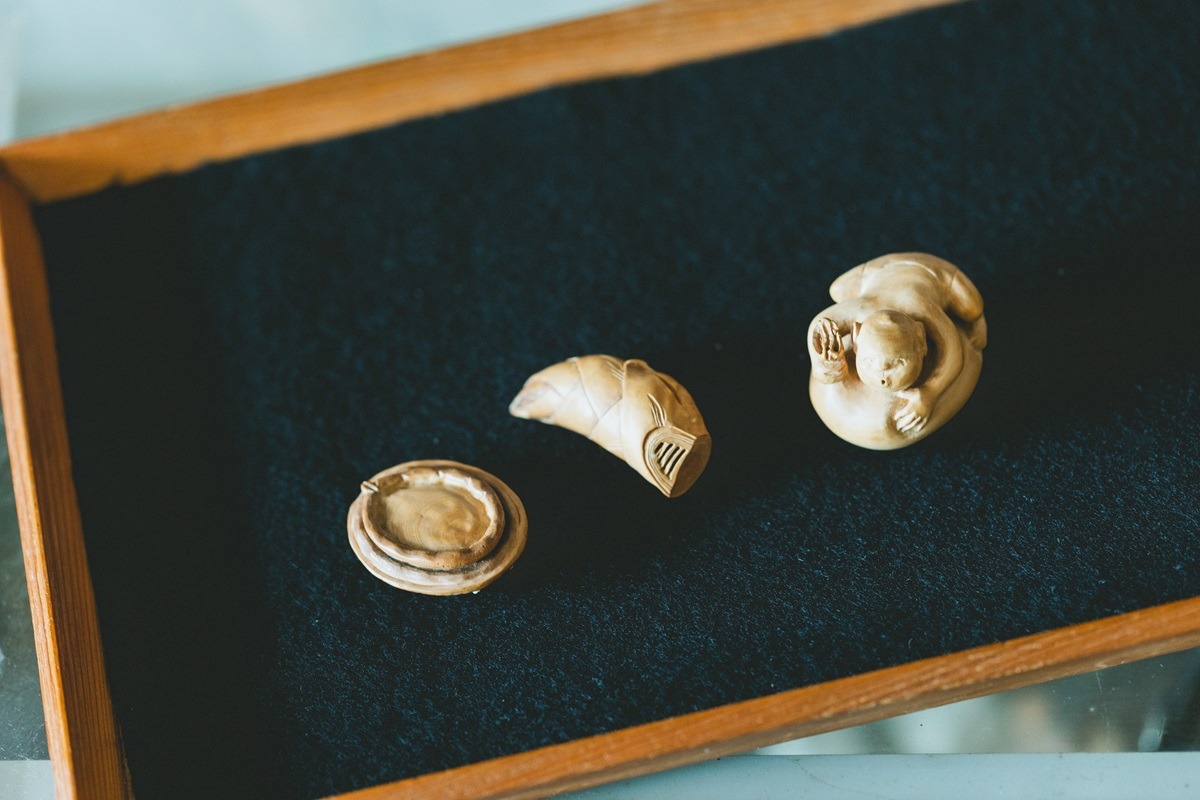
Netsuke are miniature sculpted wooden toggles that were a popular Edo-period (1603–1868) attachment for inro (medicine cases) or tobacco pouches, as well as among visitors to Ise Shrine. Internationally, netsuke are prized as one of Japan’s four major traditional crafts along with ukiyo-e, blades, and lacquerware, and displayed in the British Museum and the Museum of Fine Arts Boston.
The director of the Ise City’s Ise Netsuke Sculpture Museum, Nakagawa Tadamine is self-taught, having entered the field at the age of 30. Now 77 years old, he is also the head of the Ise branch of the International Netsuke Carvers’ Association.
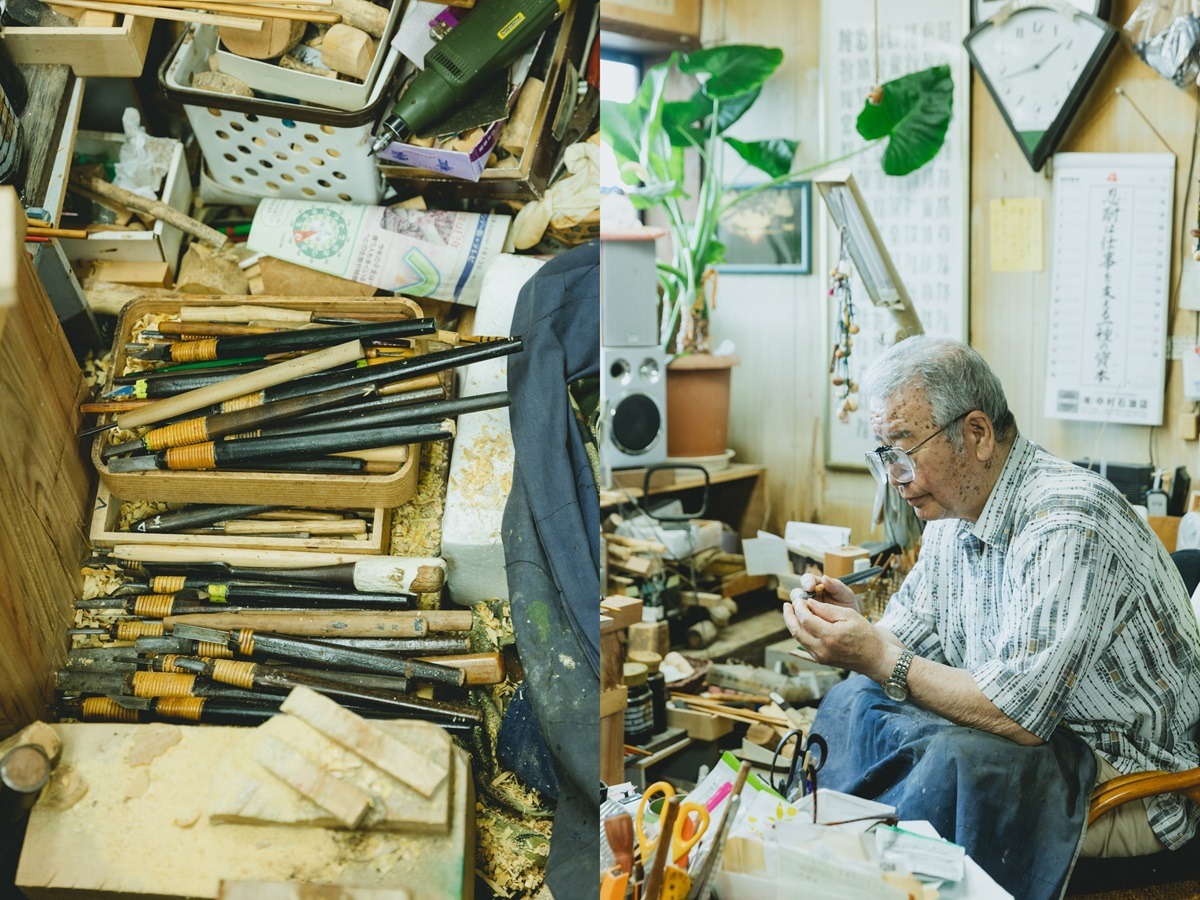
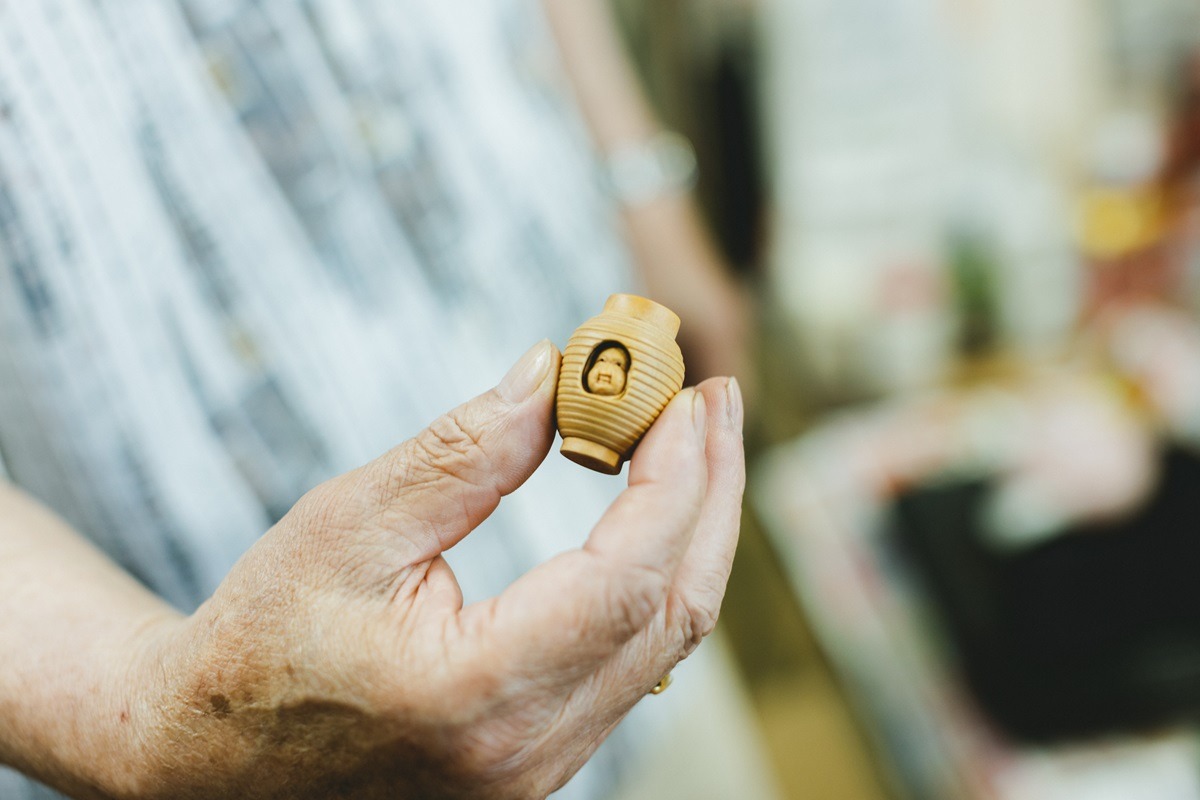
“I worked as a carpenter before and made the transition from large objects to small ones. Perhaps my ability to shape things with a balanced perspective as a carpenter was valued,” says Nakagawa. He specializes in intricate karakuri (trick/mechanical) netsuke, which require particularly fine craftsmanship, as pictured.
A netsuke is considered to have good shape if it fits snugly in the hand, with a smooth feel and rounded appearance. Netsuke are traditionally worn around the waist as a fastener for traditional clothing, at a 45-degree angle from the viewer’s perspective. A netsuke’s being just in sight was considered to have iki (style/chic) when worn in the Edo period. Even today, netsuke are attached to wallets, bags, or mobile phone straps as lucky charms.
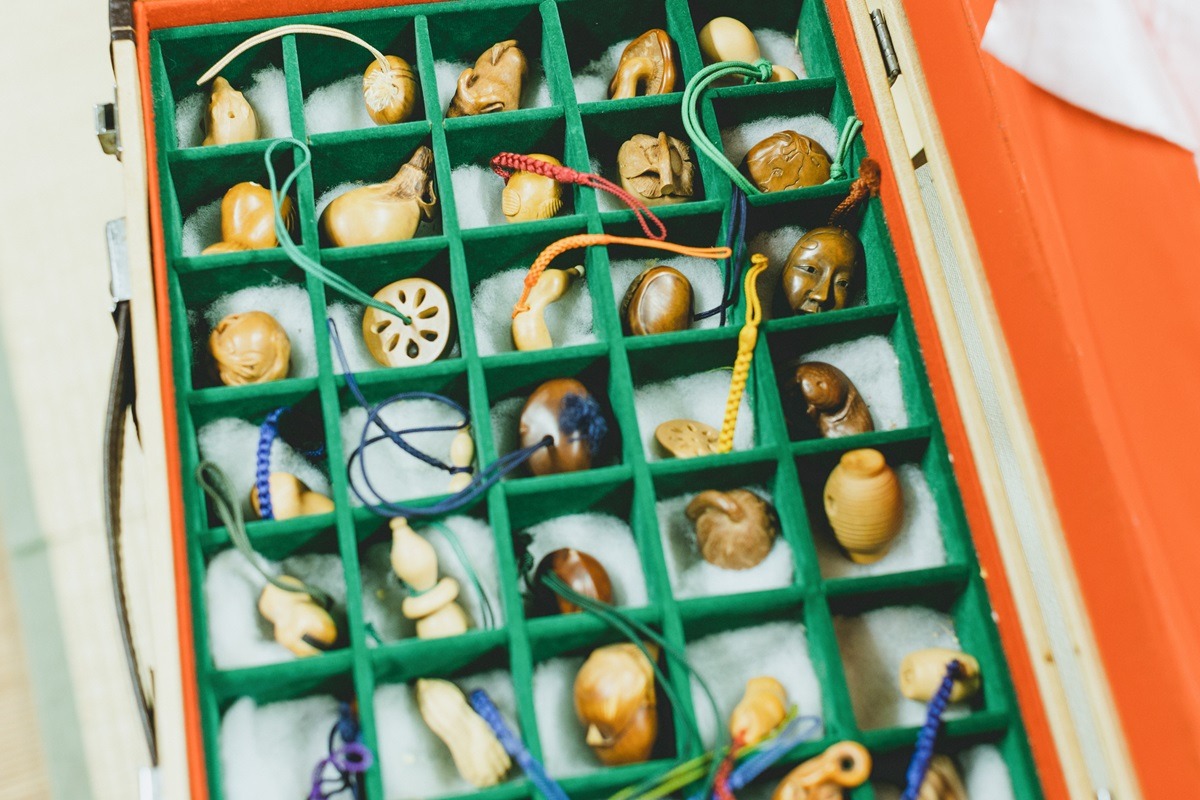
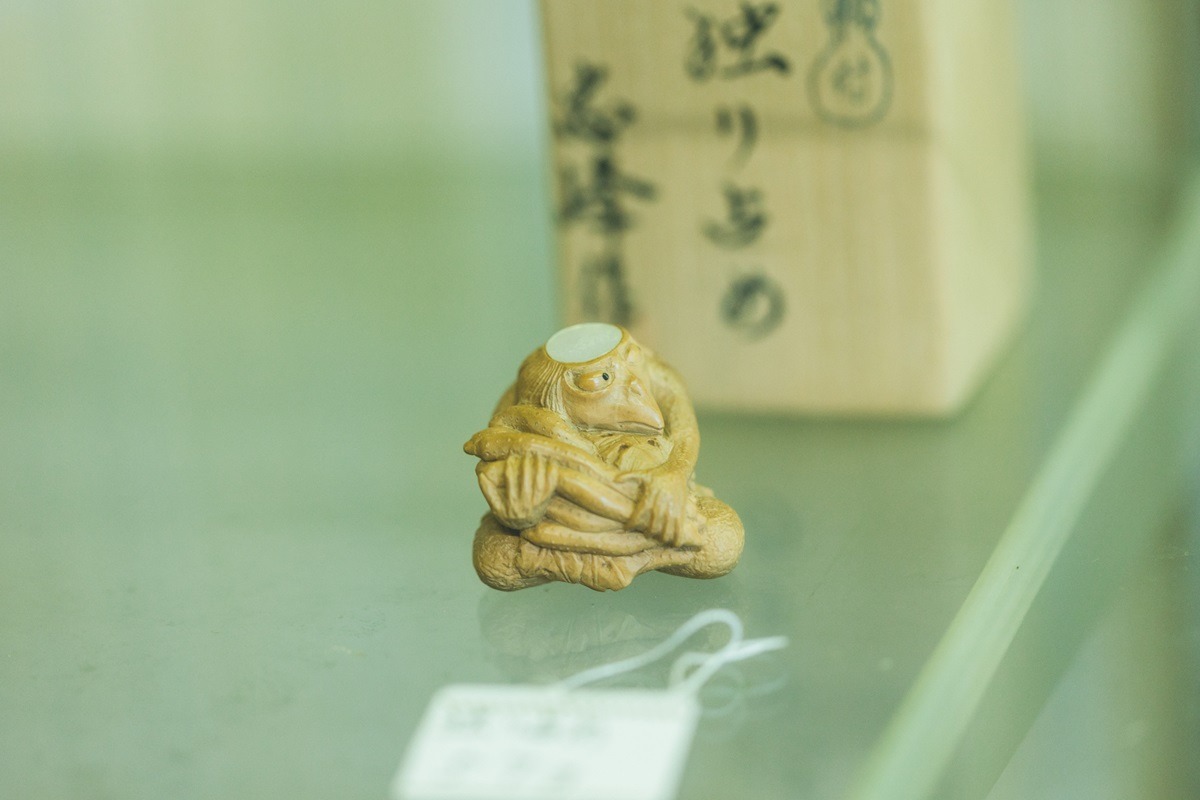
The characteristic material used for Ise netsuke is true boxwood, specifically boxwood from Asama Mountain, a sacred area of Ise Jingu. Known in Japanese as Asama tsuge, it is extremely rare and precious. Asama boxwood trees themselves grow slowly, creating tight, dense growth rings and strong, unyielding wood.
Nakagawa, with special permission, enters the mountain himself to the amount of Asama boxwood that he requires. Smooth, straight branches are easier to carve and result in better finishes. He takes pains not to over-harvest, cutting above new buds to encourage future growth.
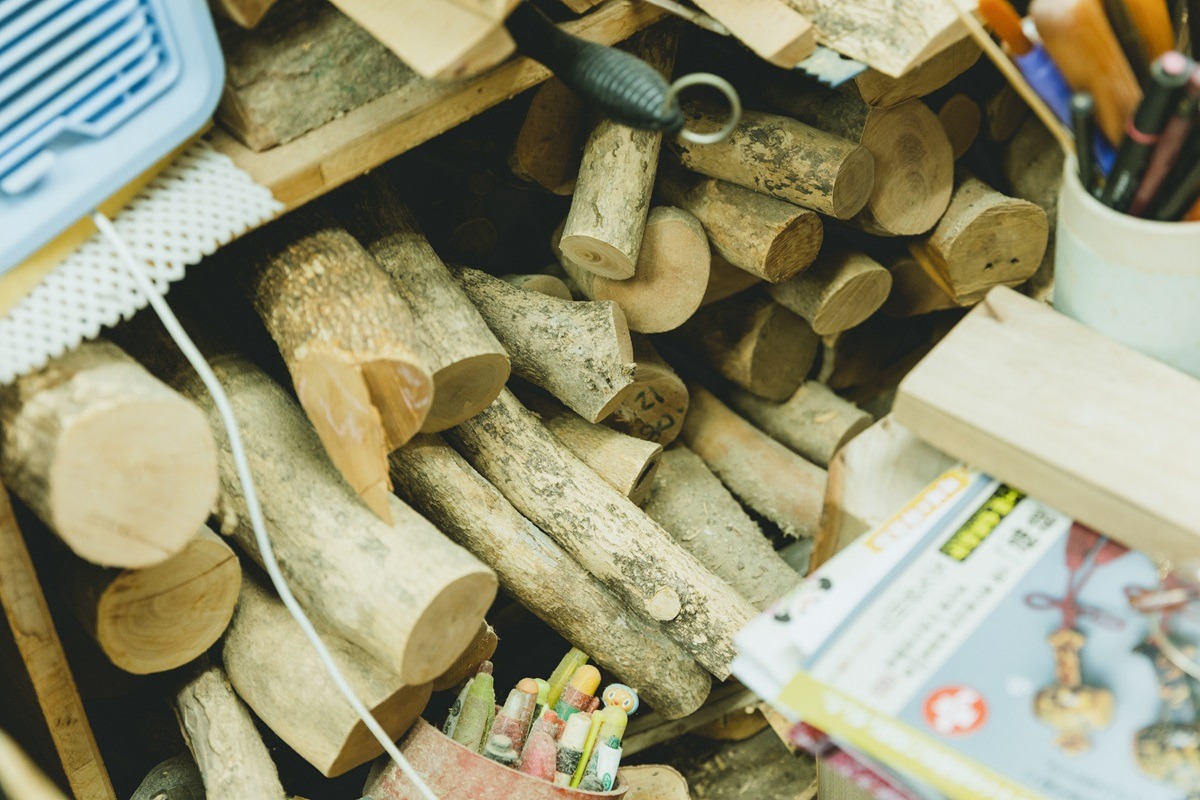
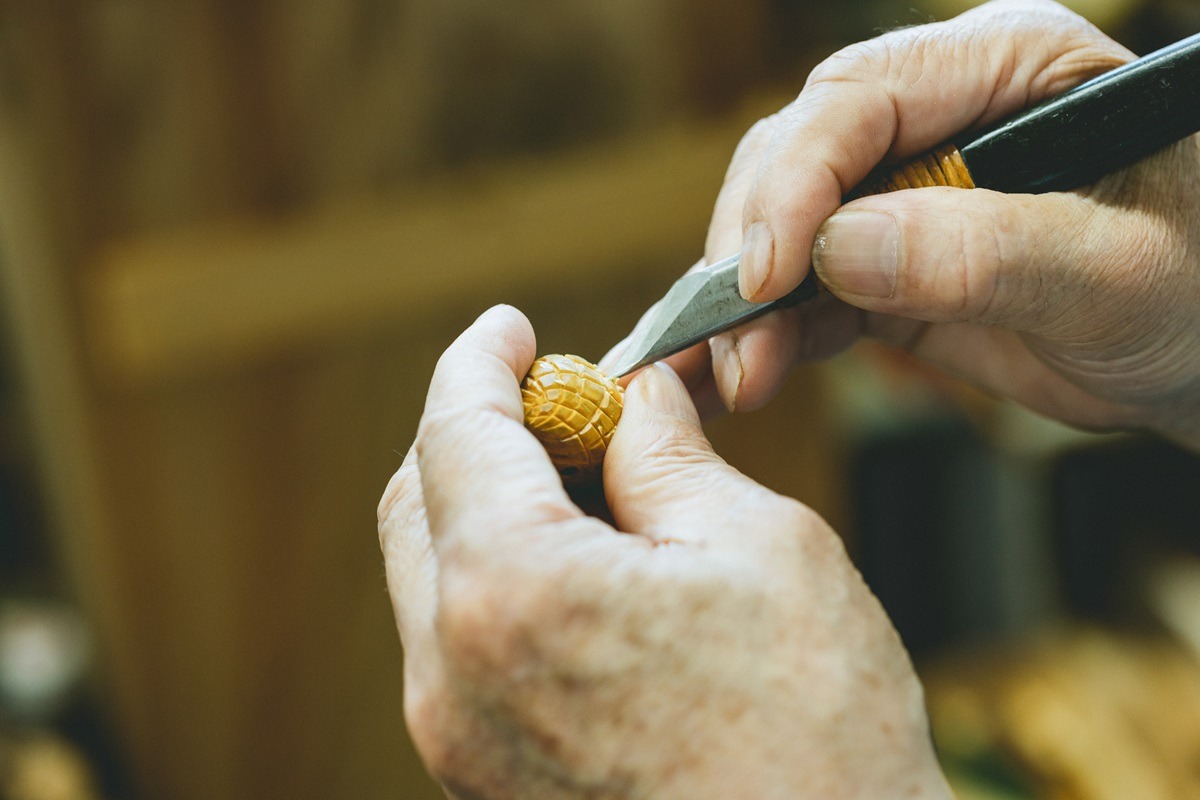
Netsuke, though valued as works of art, are fundamentally tools, brought to life by those using them. Well-used netsuke that have turned amber over time are called nare, and boxwood in particular develops a beautiful aging luster the more it is used. In daily usage netsuke are rubbed by clothing, absorbing oils from hands and being exposed to sunlight, resulting in beautiful colors that emerge through their use. While artificial colors can lose their vitality over time, natural hues retain a lasting appeal.
At the Ise Netsuke Sculpture Museum, visitors can view Nakagawa’s works up close and even experience netsuke carving for themselves. Nakagawa’s works are available for purchase at the museum’s workshop or at occasional department store events.
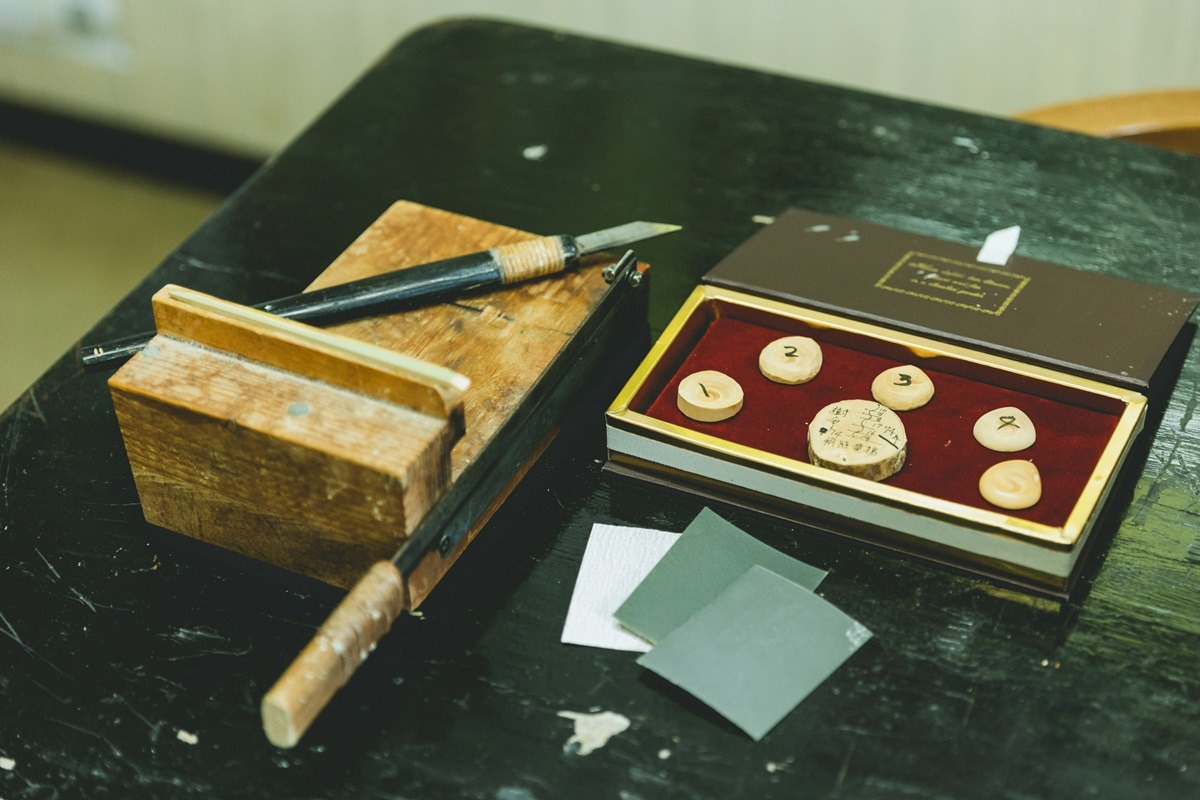
Ise Netsuke Sculpture Museum
Address: 1358 Ueji-cho, Ise-shi, Mie-ken
Tel.: 0596-25-5988
Closed: Tuesdays and irregular holidays
Hours: 10:00-15:00
Casually Enjoying Matsusaka Cotton Kimono at the Utsukushiya/Higashimura Kimono Store
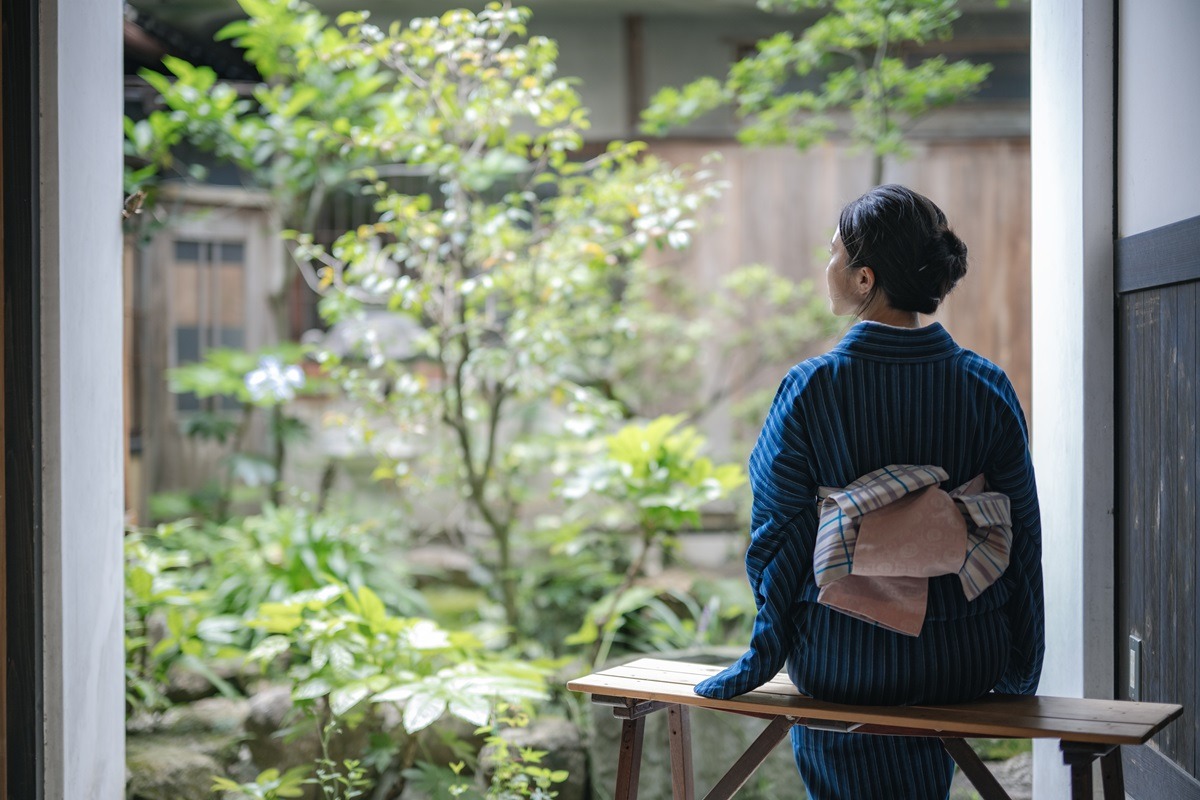
Matsusaka City flourished as a commercial town during the Edo period (1603–1868). The city still retains the houses of former wealthy merchants, as well as castle ruins and samurai residences, evoking an effortless retro atmosphere. This is the birthplace of Matsusaka cotton, sold widely by merchants and the cause of a major boom in the capital of Edo (Tokyo).
Utsukushiya/Higashimura Kimono Store offers visitors an authentic experience of Japanese culture, kimono included. Founded in 1924, the store has since been renovated and, in addition to selling kimono, offers dressing services, tea ceremony, calligraphy experiences, as well as lodgings in a converted warehouse.
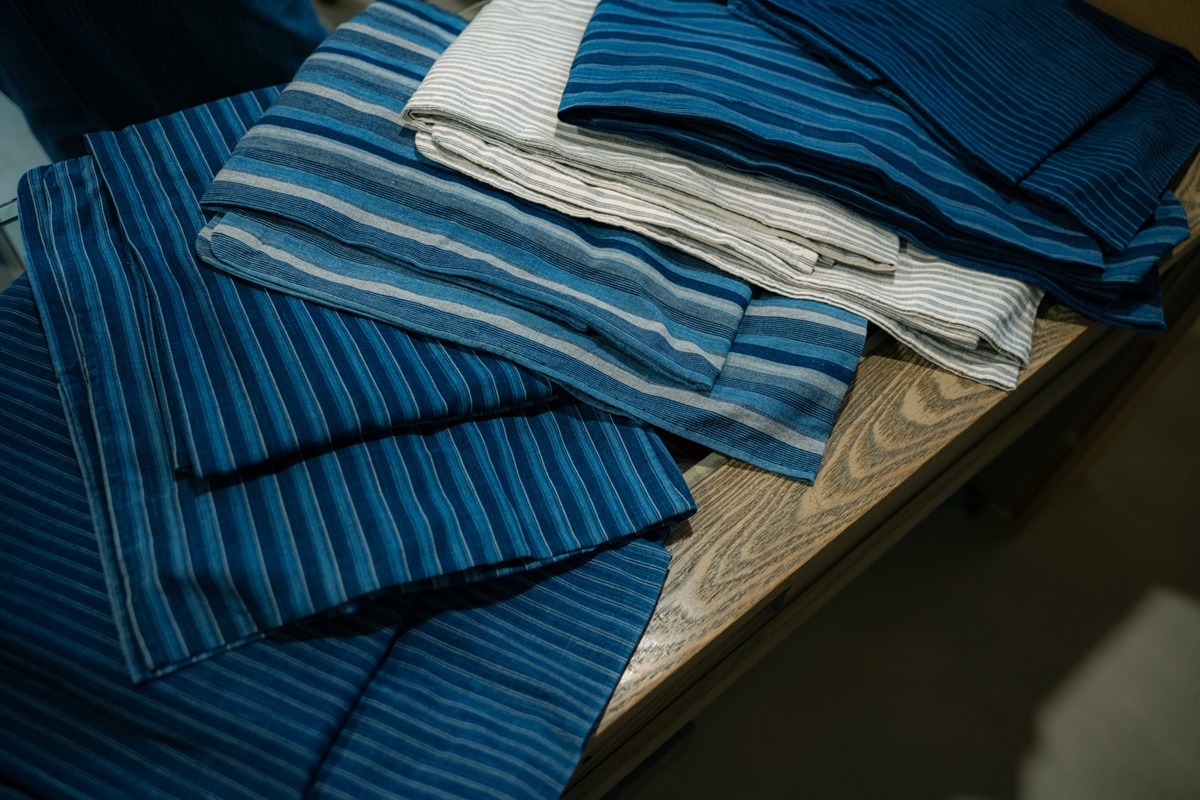
Owner Yoshiko Higashimura dresses customers in Matsusaka cotton kimono herself and offers visitors the opportunity to experience a Japanese tea ceremony.
Matsusaka cotton is a type of cotton fabric dyed with natural indigo and woven into stripes. In the Edo period (1603–1868), women from agricultural families in Matsusaka hand-wove a bolt of cloth overnight for shipment the next day. The simplicity of appearing solid-colored from a distance and striped up close was considered iki, or chic, and Matsusaka cotton became extremely popular among the common people of Edo. Records show that at the time, when the population of Edo was only about one million, 550,000 bolts of Matsusaka cotton were shipped annually. Edo as a city was so synonymous with the striped fabric that when kabuki actors wore striped costumes, they would say they were “wearing Matsusaka.”
“As it is fine to be home-washed, you can treat Matsusaka cotton just like everyday clothing. I want people to wear it freely, whether for a stroll or dinner, without fear of getting dirty,” says Higashimura. “Matsusaka cotton changes with exposure to sunlight and the quality of the water used to wash it—the way it has of becoming more personal the more you use it is one of its many charms.”
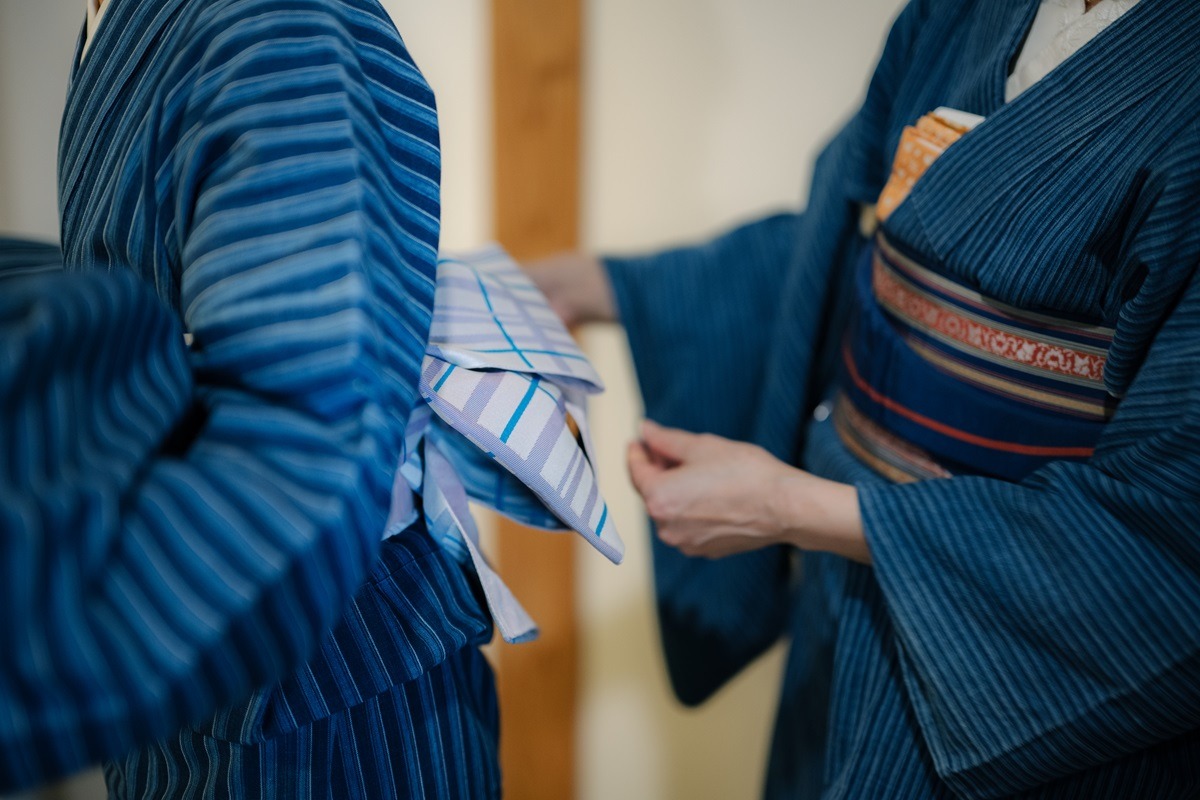

While wearing a Matsusaka cotton kimono, visitors can move on to the tea ceremony experience, enjoying matcha and seasonal wagashi, or Japanese sweets, that you make yourself. Higashimura teaches the basic usage of tea ceremony tools and etiquette, but the main focus is simply on savoring the tea and casually passing time in a traditional manner, all the while listening to Higashimura’s curious facts and anecdotes about the history of Matsusaka.


Utsukushiya/Higashimura Kimono Store
Address: 1940 Nakamachi,Matsusaka-shi,Mie-ken
Tel.: 0598-21-0220
Japanese Culture Experience: 30 minutes to 1 hour, 6,600 yen and up (reservation required)
Upholding a Dyeing Tradition: Discover the Legacy of Ise Katagami at the Suzuka Municipal Museum of Traditional Arts and Crafts

The art of Ise katagami, a strong influence on the British Arts and Crafts Movement and French Art Nouveau, is integral to the katazome stencil-dyeing method used for kimonos and other items. The process of Ise katagami involves carving patterns into kataji-gami, a stencil paper made by laminating 3 to 4 sheets of durable Mino washi paper with persimmon tannin, then drying and smoking them. While the origins of this craft are debated, with one legend claiming that a follower of Koyasu Kannon (the guardian of children and childbirth) came up with the idea after observing insect-eaten leaves, the history of Ise katagami spans over 1,000 years. Designated as a traditional craft in 1983, 99% of it is still produced in the Shiroko area of Suzuka City, Mie Prefecture.
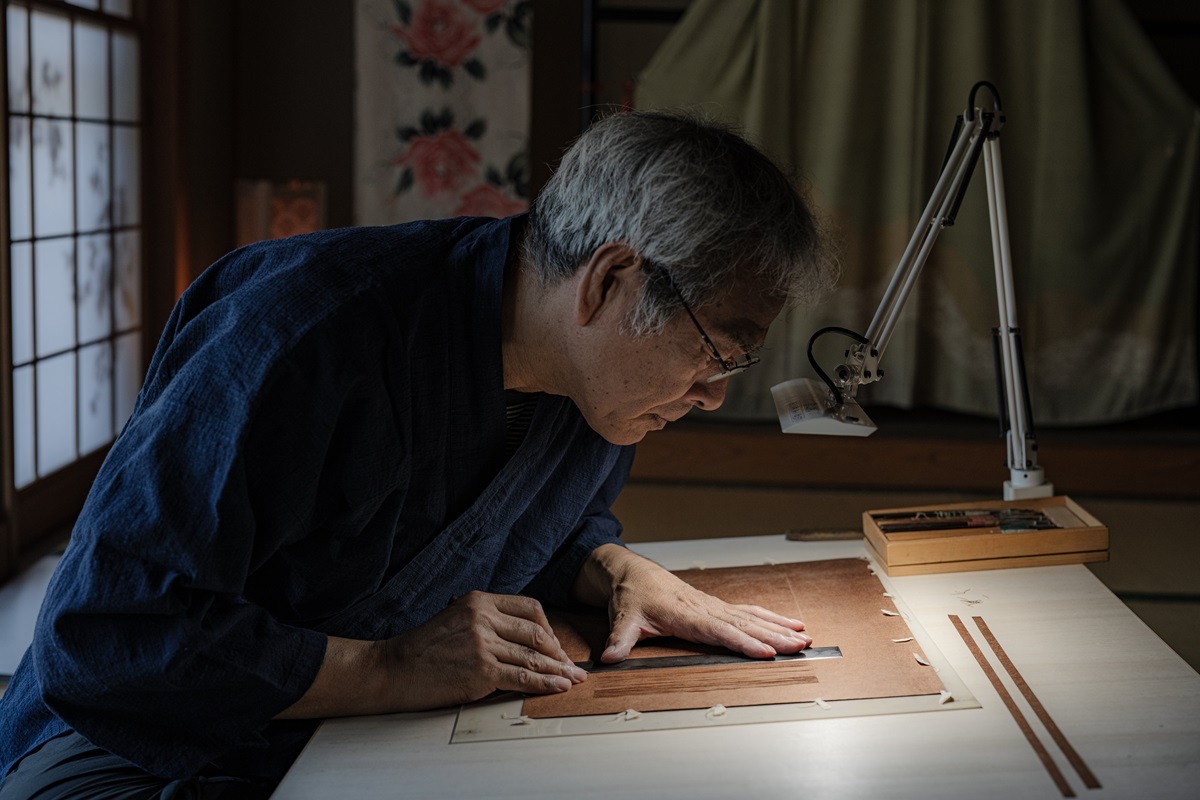
Ise katagami is distinguished by four traditional carving techniques hiki-bori (stripeline carving), tsuki-bori (jigsaw carving), dogu-bori (punch carving), and kiri-bori (drill carving) of which each artisan specializes in a particular one. At the Suzuka Municipal Museum of Traditional Arts and Crafts, visitors can observe Kobayashi’s work, in particular his specialist technique of hiki-bori using a ruler. In Kobayashi’s words, “It is the simple patterns that are the hardest to perfect.”
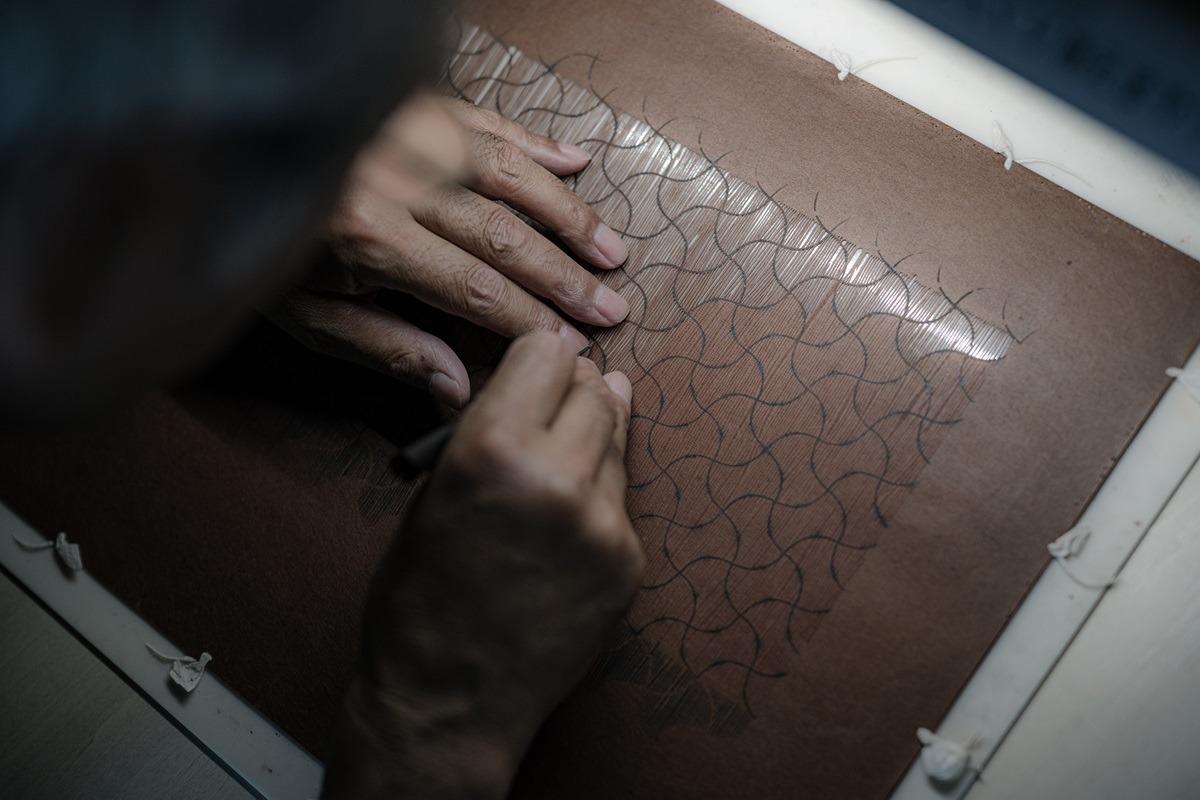

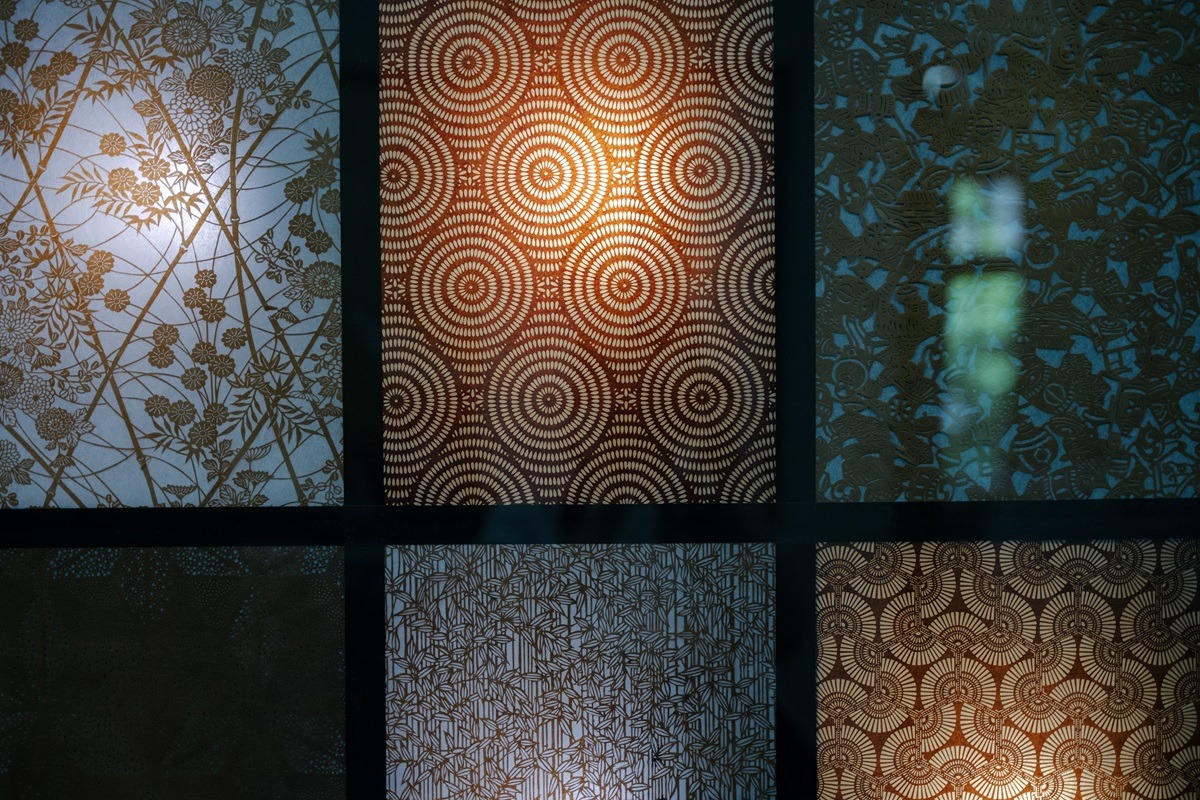
Ise katagami, with its intricate and precise designs, is not just a tool but a work of art. The Suzuka Municipal Museum of Traditional Arts and Crafts also has a gallery selling items such as Ise katagami postcards, fans, and LED stencil light kits, ensuring the continuation of the traditional craft by adapting its forms and uses. The possibilities for what such a refined yet functional art could be used for appear endless!
Suzuka Municipal Museum of Traditional Arts and Crafts
Address: 3-10-1 Jike, Suzuka-shi, Mie-ken
Tel.: 059-386-7511
Hours: 9:00–16:30
Closed: Mondays (or the next day if Monday is a holiday), year-end and New Year holidays (December 28–January 4)
Admission: Free
Stencil Carving + Dyeing Workshop: handkerchief, 1,500 yen; pouch, 2,000 yen; eco-bag, 2,500 yen; instructor fee, 11,000 yen and up. (Reservation required, approximately 2–3 hours.)
Weaving toward Future Generations with Iga Kumihimo at Hirosawa Tokusaburo Kumihimo Workshop
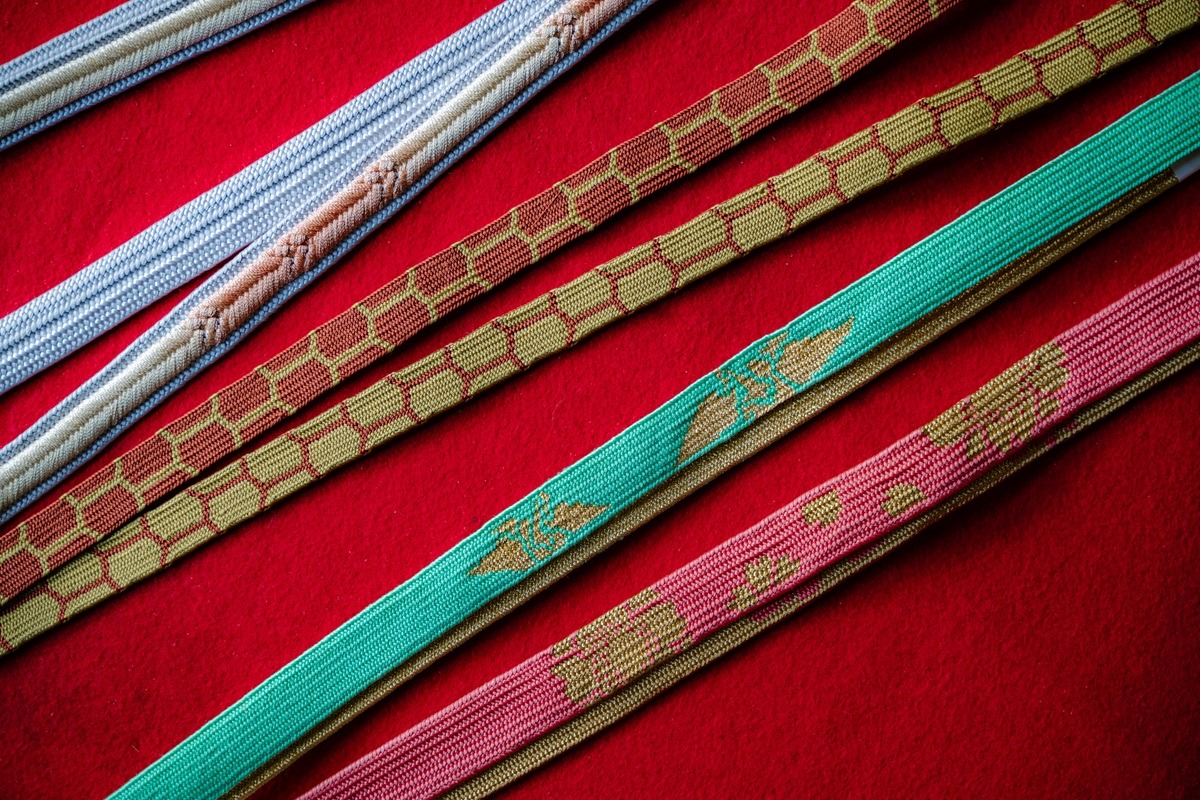
An obi-jime is a cord that secures the obi sash of a kimono, completing the look. Kumihimo is one such type of cord, a braid made from several to dozens of silk threads.
Kumihimo has been practiced in Japan since the Nara period (710–794) and was used for samurai armor and to secure sword sheaths during the Sengoku period (1467–1615). Although its use declined after the Meiji era’s Sword Abolishment Edict of 1876, it re-emerged in traditional Japanese attire.
Iga kumihimo’s origins trace back to 1902, when Hirosawa Tokusaburo returned to Iga after learning kumihimo techniques in Edo. Although kumihimo was historically produced in Iga, Hirosawa Tokusaburo Kumihimo Workshop played a significant role in its modern resurgence. Today, most takadai-gumi (braids made on a high stand) in Japan are Iga kumihimo.

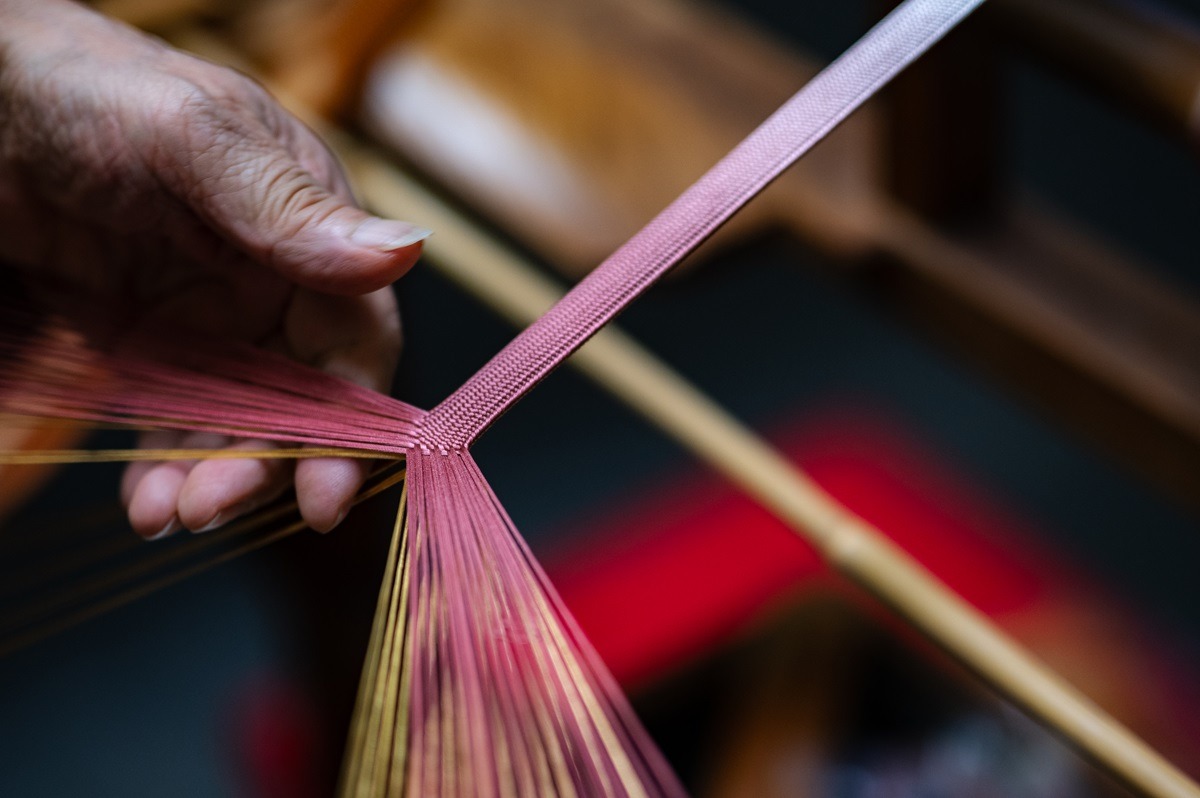
The current custodian of the workshop is the third-generation Hirosawa Tokusaburo, whose craftsmanship has even managed to catch the attention of the Japanese imperial family. Using tools like the high stand and tracing spatula, he weaves intricate designs from numerous silk threads with consistent rhythm and pressure. His process involves a self-made design blueprint called aya-gaki, which can take up to 10 years to master. Becoming a traditional craftsperson in kumihimo once required over 20 years of dedication, and Hirosawa is also committed to training the next generation of artisans.
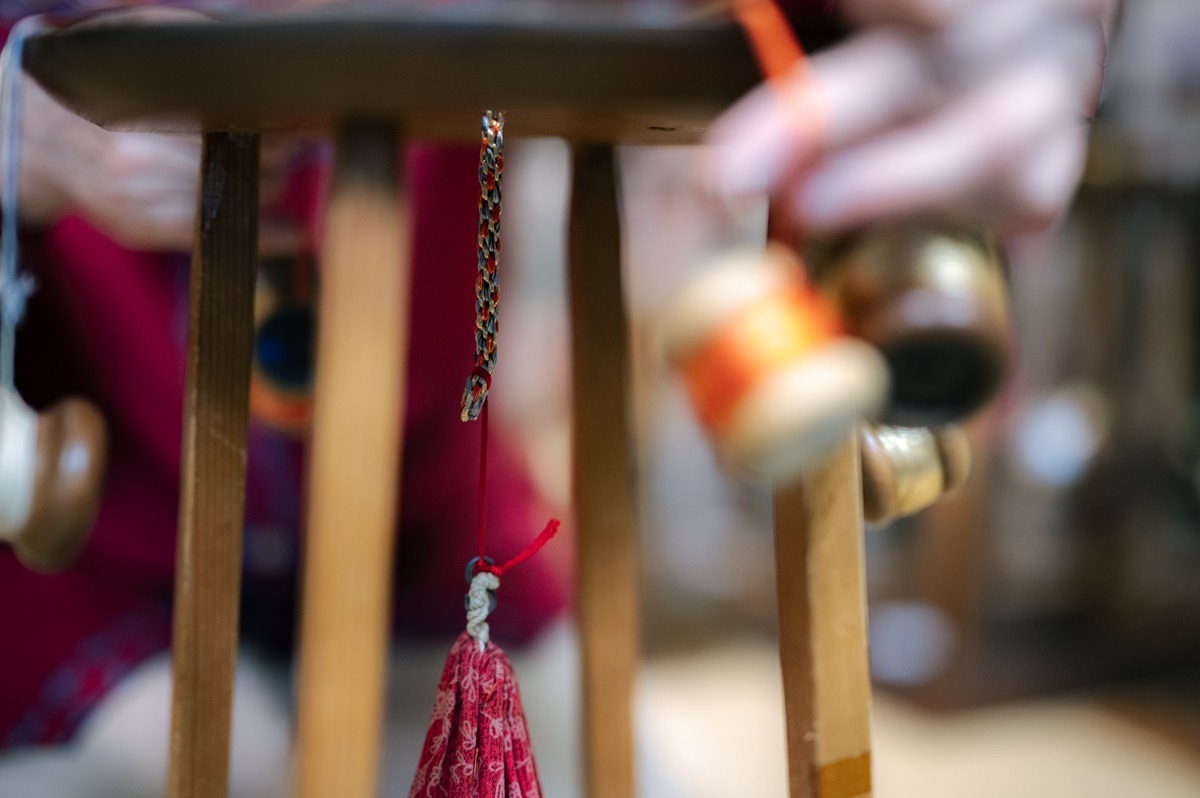
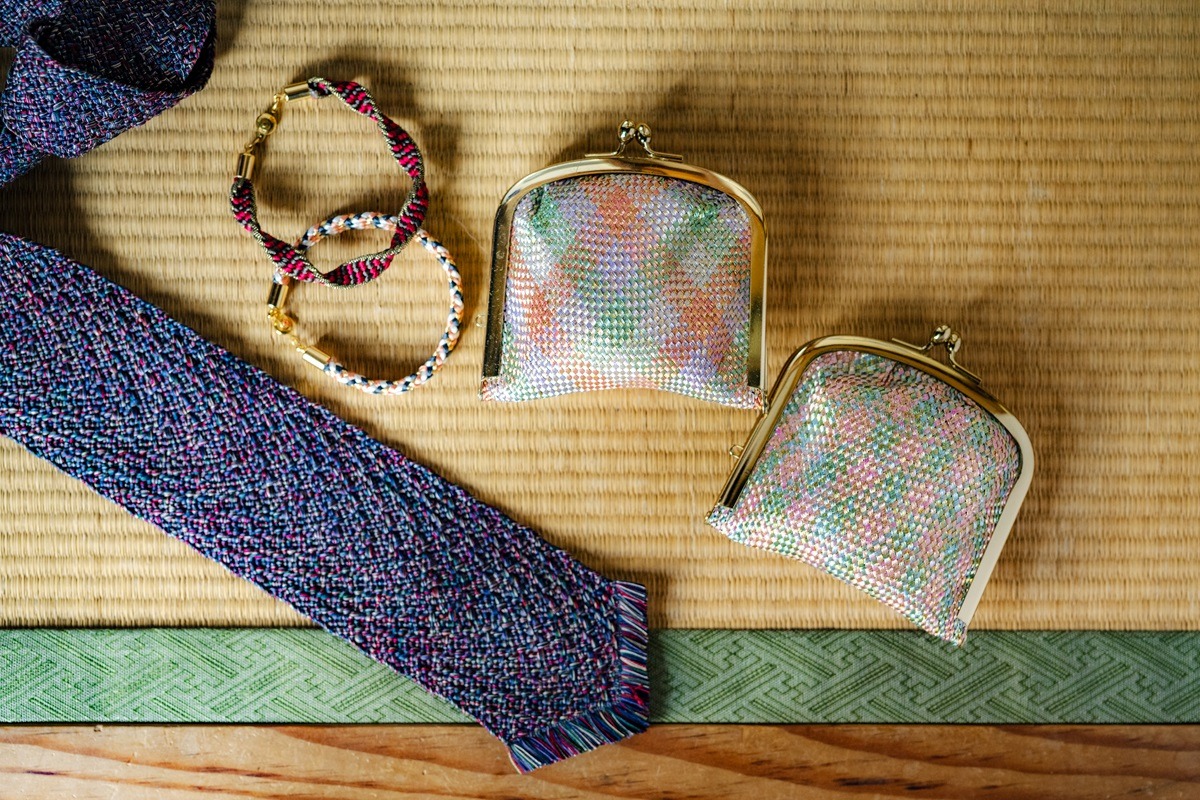
In addition to traditional obi-jime sash cords, Hirosawa Tokusaburo Kumihimo Workshop offers numerous kumihimo items that have been adapted to our modern era, such as neckties and accessories, each one a testament to the masterful skill of its artisan.
Hirosawa Tokusaburo Kumihimo Workshop
Address: 3635-1 Uenonishiote-cho, Iga-shi, Mie-ken
Tel.: 0595-21-1127
Hours: 10:00–17:00
Closed: Irregular holidays
Nagatani-en’s Iga Ware, Treasured by Professional Chefs
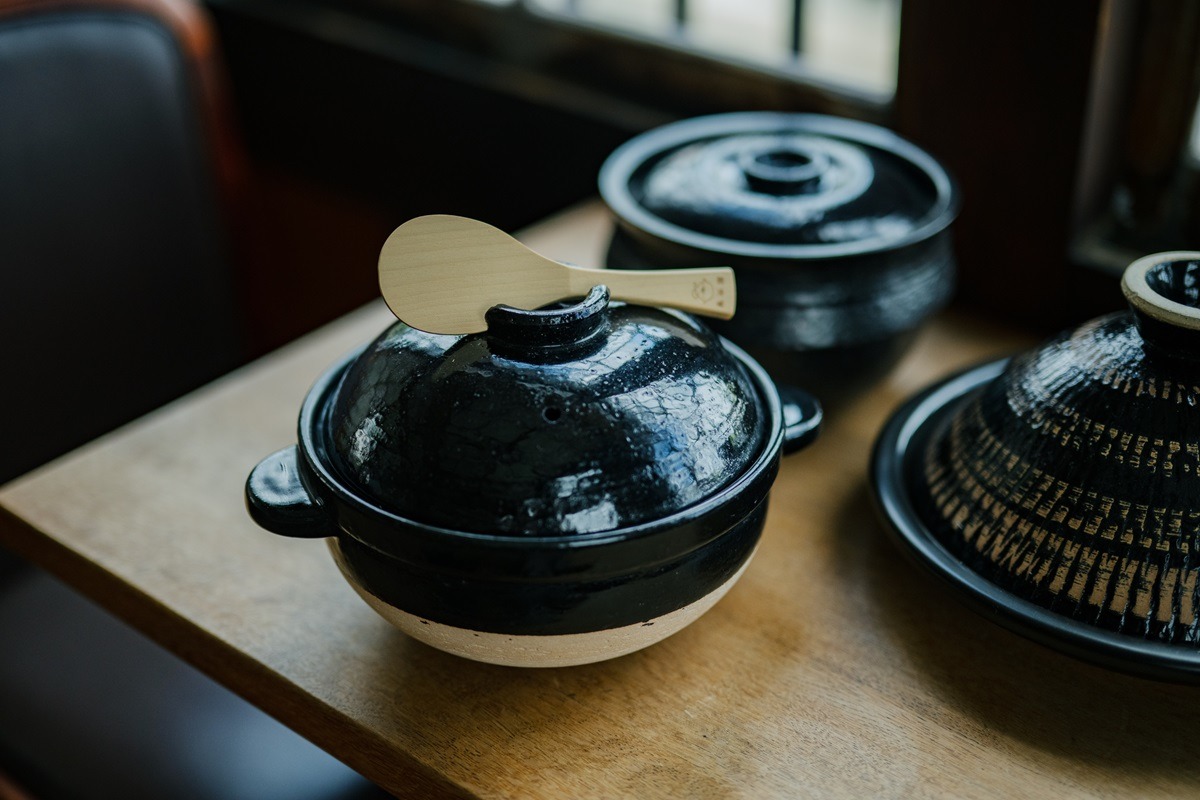
When it comes to dining, ceramics embody the “aesthetics of utility.” Long ago, the Iga region in Mie Prefecture was the bottom of Lake Biwa, Japan’s oldest and largest lake, formed 4 million years ago. Iga ware is made from coarse clay found in this region, and its origins are said to be around 1,200 years old. The clay contains fossilized microorganisms, and when fired, these fossils burn away, creating tiny pores in the clay. Cooking with Iga ware allows these pores to store heat, which slowly yet thoroughly cooks the ingredients, enhancing their flavor.
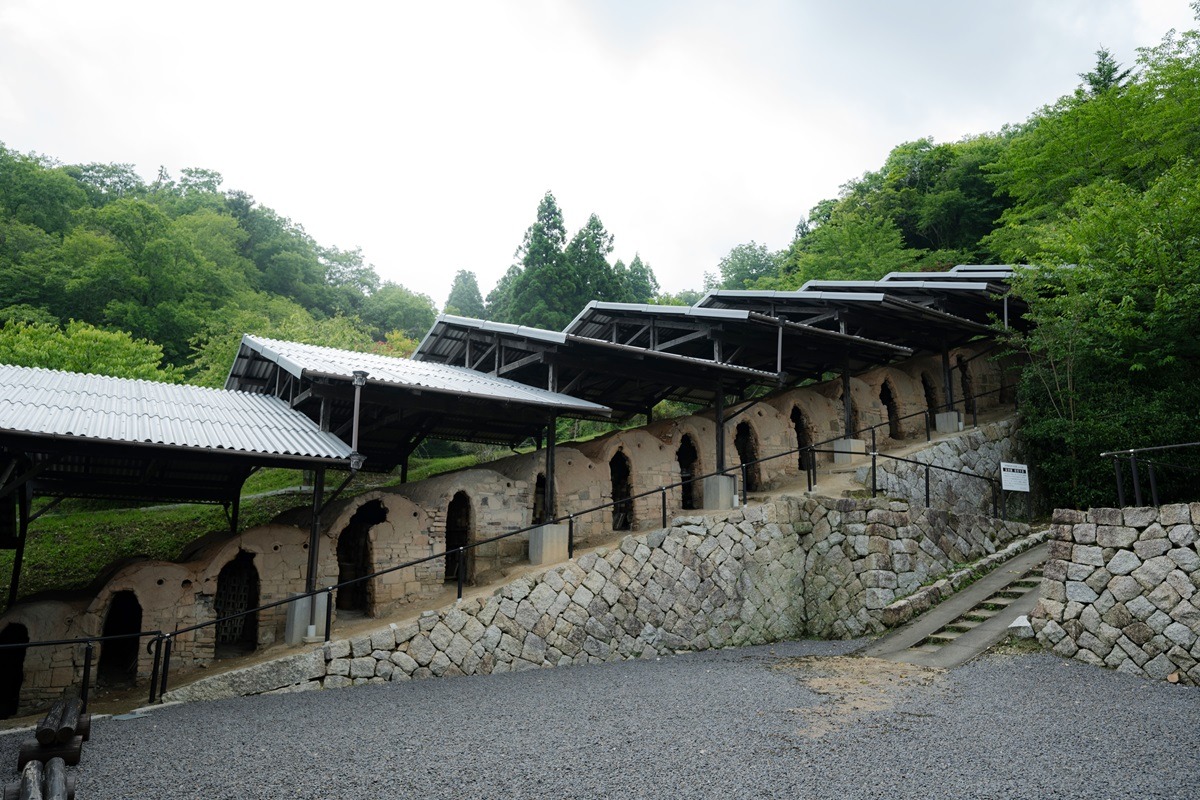
Since its founding in 1832, Nagatani-en has produced cooking utensils that make use of the functionality of Iga ware, adapting fluidly to changes in lifestyle. This kiln made Iga ware famous and led to the development of products such as the Kamado-san earthenware rice cooker, which reproduces the fluffy texture of rice cooked over a traditional stove without needing to adjust the heat, making it beloved among professional chefs. Other products include functional earthenware pots specialized for boiling, grilling, steaming, and roasting, the development of which is always driven by the workshop motto, “The maker is the true user.”
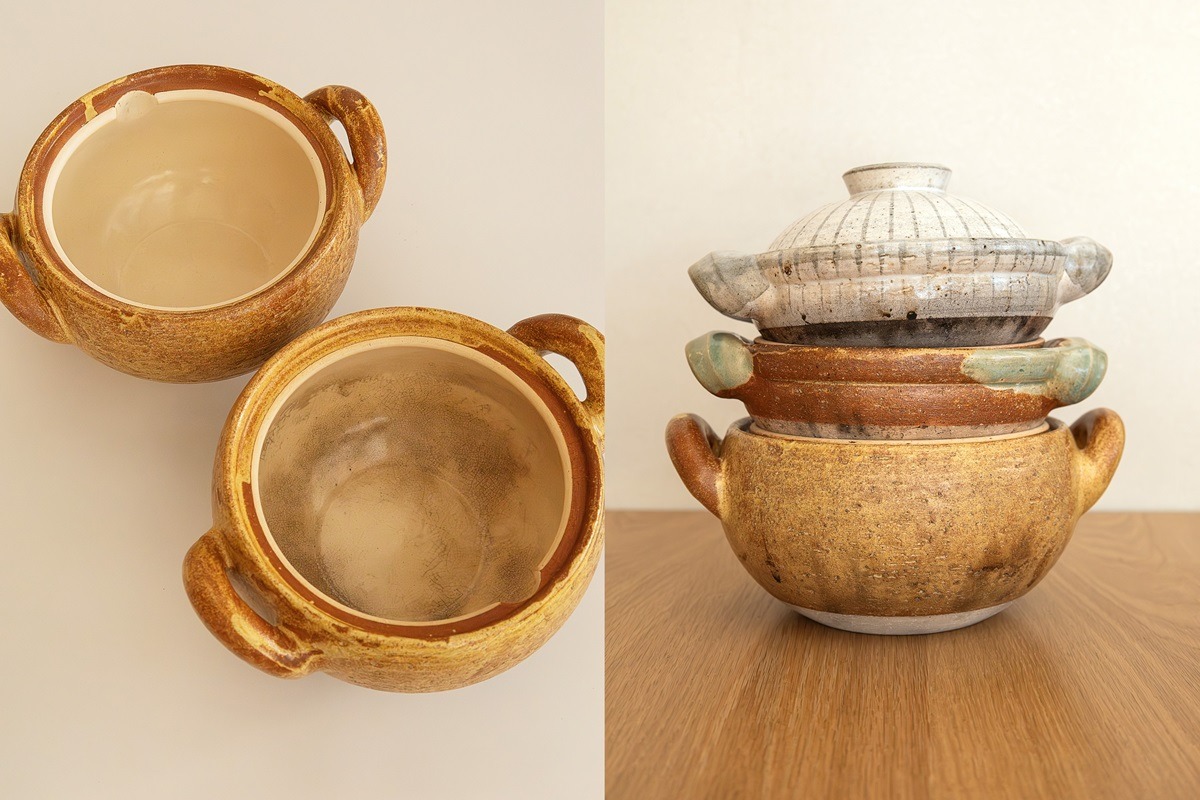
Iga ware is not only excellent for cooking utensils but works just as well as tableware,” says Nagatani Saaya, a successor to Nagatani-en. At the historic ceramic-maker, they also create sake and tea utensils that take advantage of the unique texture of Iga’s coarse clay. For example, beer mugs unglazed on the inside have a rough surface that makes the beer foam creamier. Similarly, coffee cups with an unglazed inner surface help remove any bitterness from coffee, resulting in a smoother, milder flavor. The pores in the clay not only store heat but also have a cooling effect, so soaking them in water and then refrigerating them keeps food and drinks cold for longer.

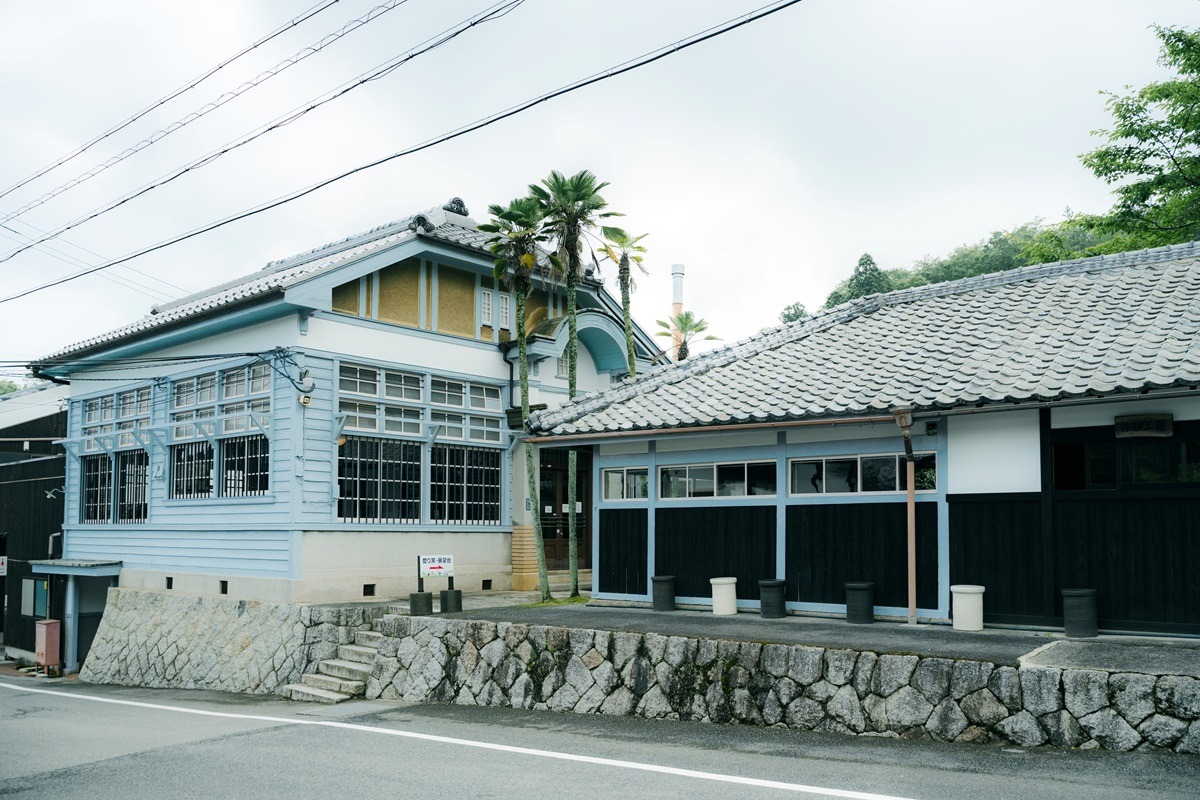
Nagatani-en
Address: 569 Marubashira, Iga-shi, Mie-ken
Tel.: 0120-529-500
Hours: 10:00–17:00
Closed: New Year and Obon holidays
Suigetsu Toen’s Banko-Ware Ceramics: Mild, Well-Rounded Tea with the Shidei Kyusu Teapot
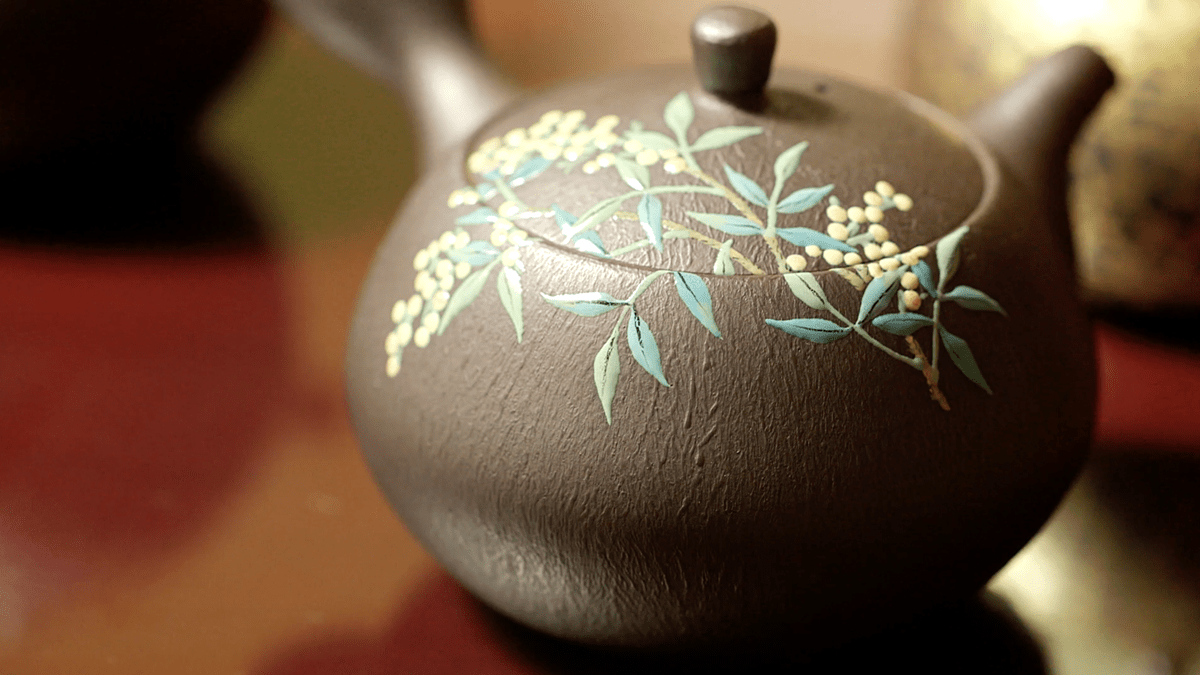
Yokkaichi City in Mie Prefecture is another area well-known for its ceramics. Banko ware originated in the mid-Edo period (1603–1868) with the opening of a kiln by wealthy merchant Nunami Rozan. The name “banko” is said to come from the banko or banko fueki stamps that Rozan impressed on his works, which carry the meaning “ever to be passed down”—a rare case of a ceramic not named after the location it is made in.
Banko ware developed into a local industry in Yokkaichi during the Meiji era (1868–1912). Today, its production centers are Yokkaichi City and Komono Town, and Yokkaichi banko ware was designated a Japanese traditional craft in 1979. Although banko ware is best known for its earthenware pots, the brown shidei kyusu teapots are also a cornerstone of its tradition. The clay absorbs the astringent components of tea and helps to release its inherent umami, making the two a perfect match. Yokkaichi is also one of Mie’s leading tea-producing areas.
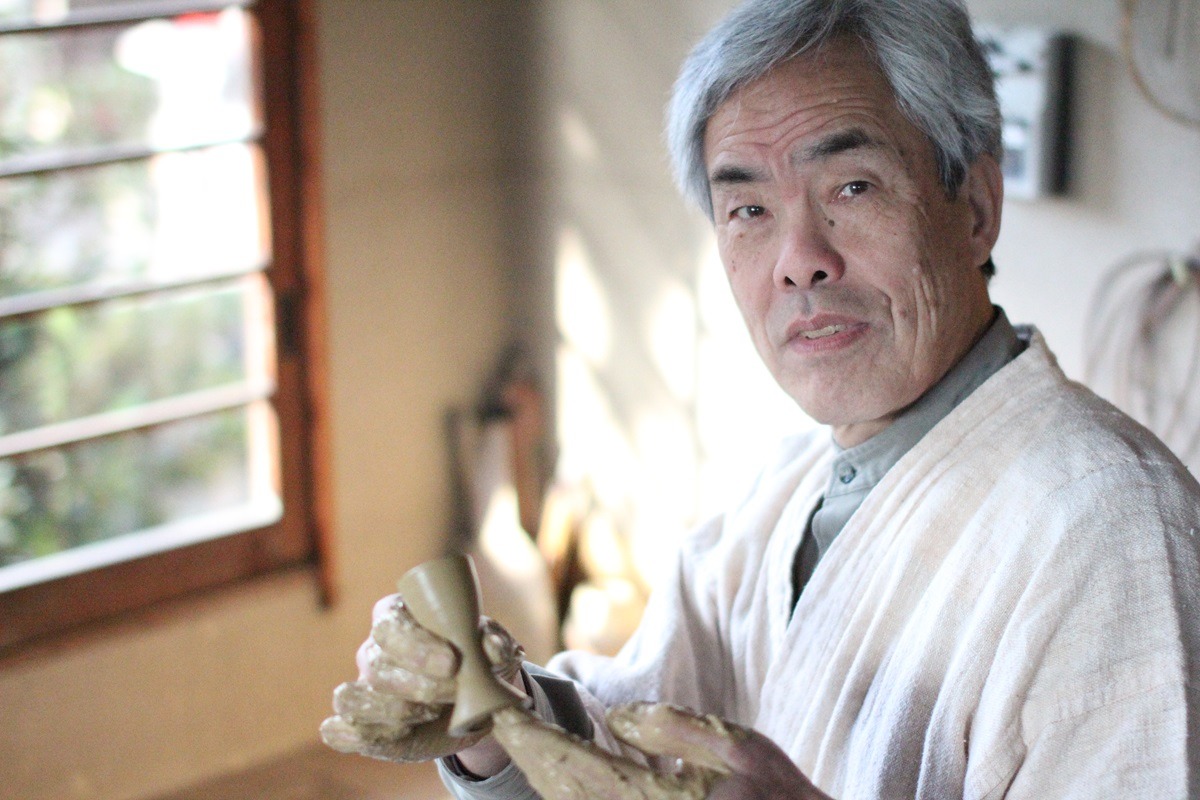
Founded in 1900, Suigetsu Toen produces banko-ware items such as teapots, vases, and tableware. The current craftsmen include the third-generation Shimizu Suigetsu, his sons Jun and Ushio, and his wife and painter Kishiyo.
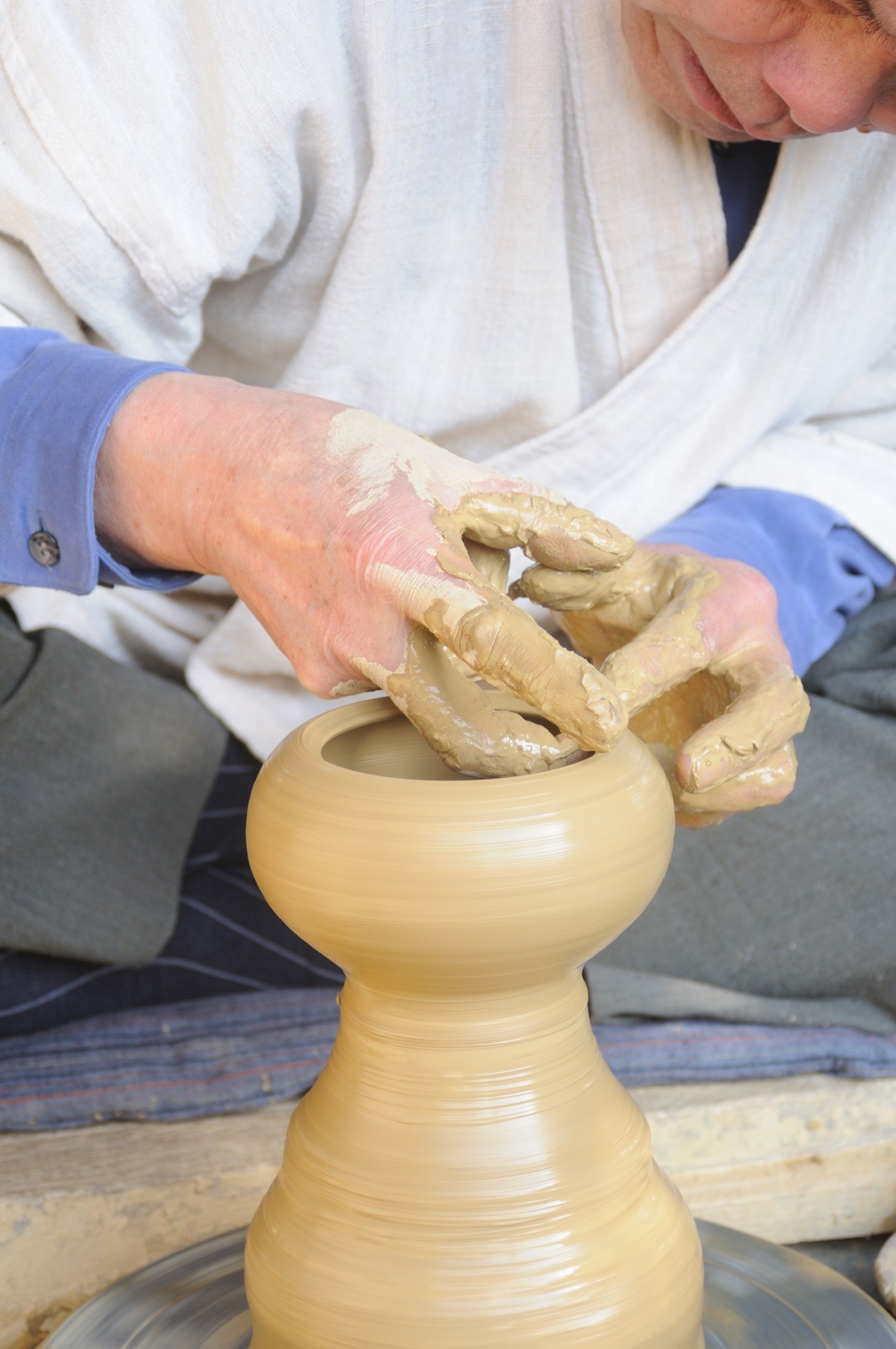

One of the key features of kyusu teapots is their ease of use. They have a clean spout that doesn’t drip, a tea strainer that doesn’t clog, a body with a high center of gravity for a lighter feel, a lid that fits well, and a rim for easy disposal of used tea leaves—each and every piece made entirely by hand.
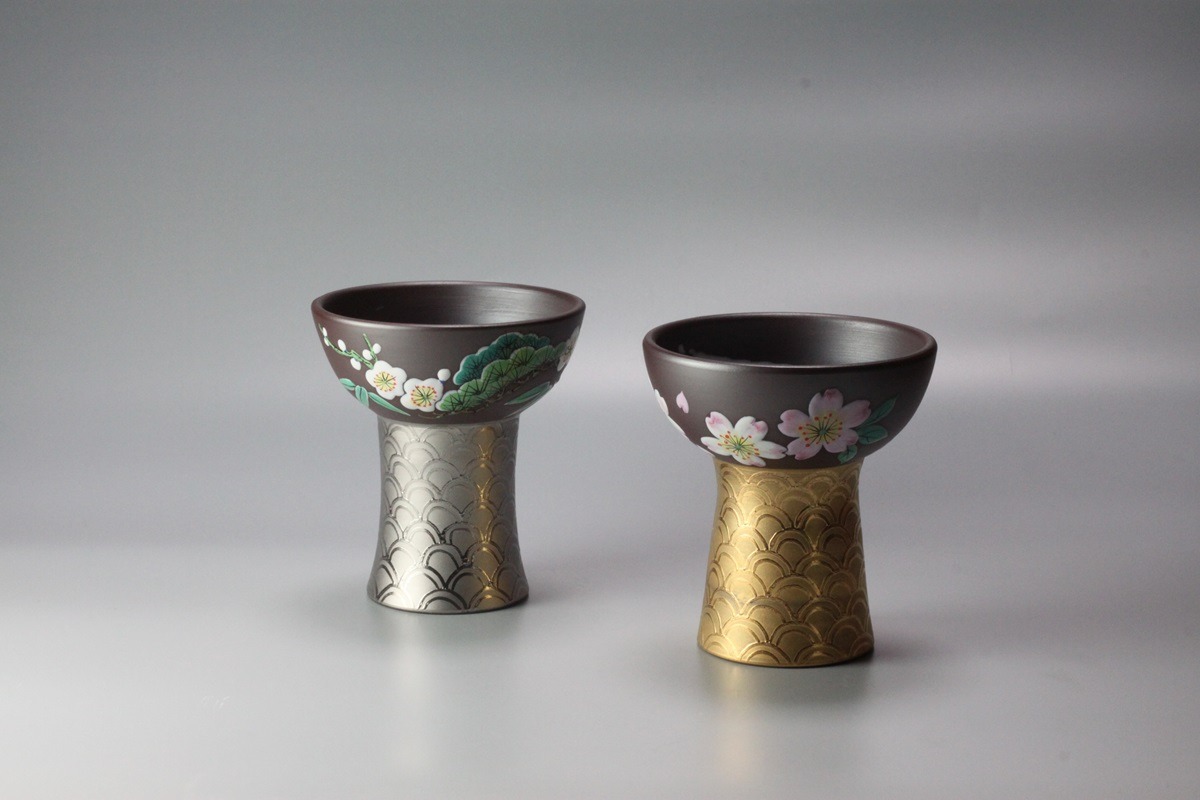
Suigetsu Toen is also dedicated to pursuing new banko ware, following the third-generation Suigetsu’s belief that the continuation of tradition relies on its acceptance by and adaption to the times. In 2016, his modern banko mori-e raised design sake cup was used at the first dinner of the G7 Ise-Shima Summit in Shima city Mie Prefecture. The kiln also collaborates on new items with brands and culinary figures such as FRANCK MULLER and the chef Kihachi Kumagai.
Suigetsu Toen offers gallery tours and one-day workshops, inviting visitors to enjoy a hands-on experience of generations of craftsmanship now blending tradition with contemporary innovation.
Suigetsu Toen (Gallery)
Address: 19-4 Minamiikaruga-cho, Yokkaichi-shi, Mie-ken
One-Day Workshop
Fee: 3,500 yen for junior high school students and above, 2,500 yen for elementary school students and below
Duration: Approx. 1 hour
※Shipping fee calculated at actual cost
※For 500 yen extra one additional piece can be made
Address: Suigetsu Kiln Yama no Kobo (1103 Nishisakabe-cho, Yokkaichi-shi)
※Reservations/Inquiries
Tel.: 059-332-8218 (Suigetsu Toen)
Access to Mie Prefecture
Mie Prefecture is conveniently accessible by JR (Japan Railways) and Kintetsu trains from Osaka, Kyoto, and Nagoya. Nagatani-en (Iga City), featured in this article, is conveniently accessible by JR, and Suzuka City Traditional Industry Hall (Suzuka City) by Kintetsu.
When traveling to Mie Prefecture by JR, the JR Pass is highly convenient.
For those who wish to explore other areas mentioned in this special feature, such as the Kumano Kodo or Wakayama, the JR Tourist Pass is recommended.
Kintetsu offers direct and fast access to Mie from Osaka, Kyoto, and Nagoya without the need for transfers. The KINTETSU RAIL PASS 5 Day / 5 Day Plus provides unlimited travel on all Kintetsu lines, including Iga Railway, for five days.

You may also like

Hidden Gems in ASEAN: Off the Beaten Path Destinations in Southeast Asia
The charm of Southeast Asia goes beyond Bangkok‘s bustle or Bali‘s beaches. While these are amazing destinations in their own right, a different side of the region lies outside of the headline destinations, particularly for those craving something quieter and more immersive. In this guide to hidden gems in ASEAN, let’s travel beyond the usual tourist trail. These are places where life moves at a different pace, where landscapes feel untouched, and where culture is lived rather than curated. If you’re looking for off the beaten path Southeast Asia experiences that still feel authentic, this list is for you.

Feel Revived by Cultural Activities & Hot Springs on a Trip to Ehime
Ehime Prefecture offers an abundance of nature and culture. It is full of exciting sea and mountain activities, such as cycling the 70 km Shimanami Kaido route around the islands in the Seto Inland Sea, trekking the Shikoku Pilgrimage, and climbing Mt. Ishizuchi—the highest peak of western Japan. You can also relax at Dogo Onsen, one of Japan’s most famous hot spring areas, or explore Ehime’s historical spots, like Matsuyama Castle and the Edo Period towns. It takes around 30 minutes to travel from Matsuyama Airport to Matsuyama City by airport bus. And with trams that travel within Matsuyama City and to Dogo Onsen, accessing tourist attractions around the area couldn’t be easier!

Your ultimate Okinawan getaway awaits! Discover, relax, and indulge at The Beach Tower Okinawa
This article is sponsored by “Kyoritsu Maintenance Co., Ltd.” Presented by Kyoritsu Maintenance Co., Ltd. / The Beach Tower Okinawa Chatan Town …

Best Hotels in Singapore: Top Stays for Luxury, Leisure, and Everything In Between
Where you stay in Singapore will play a big role in how you experience the city. Here is a look at some of the best hotels in Singapore highlighting standout stays across the city and Sentosa Island. From stylish urban retreats to family-friendly resorts, you’ll find top-notch options to match your itinerary, travel style, and budget.

Best Hotels in Malaysia: Where to Stay Across the Country
From buzzing city centers to tropical coastlines, Malaysia is a country that caters to every kind of traveler with every kind of hotel. Here’s a roundup of some of the top hotels in Malaysia that combine excellent locations, great amenities, and real value, helping you narrow down where to stay in Malaysia no matter your travel style or budget.

Top Hotels in Hong Kong: Best Places to Stay Across the City
Whether you’re visiting Hong Kong for the vibrant food scene, high-rise shopping districts, or a peaceful escape in the outlying islands, choosing the right place to stay can elevate your entire experience. This roundup of the top hotels in Hong Kong brings together stylish urban retreats, conveniently located business hotels, and relaxing escapes, all with easy access to the city’s most iconic spots. If you’re wondering where to stay in Hong Kong, these top picks are a great place to start.

Best Hotels in Taiwan: Top Picks for Every Type of Traveler
Whether you’re drawn to Taiwan for its street food, hiking trails, or vibrant cultural history, finding the right place to stay can make your trip even more memorable. The best hotels in Taiwan offer more than just a place to sleep; they help complete the whole experience. Whether you’re staying for a weekend or a few weeks, these hotel recommendations will help you find the right fit for your travel style.
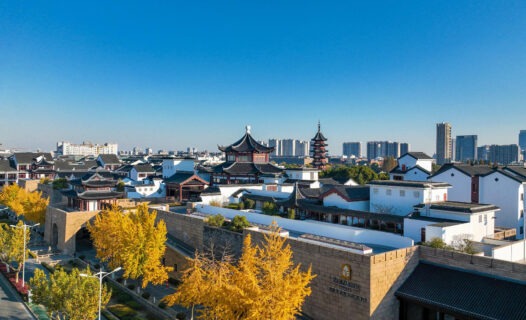
Best Hotels in China: Top Stays from Shenzhen to Suzhou
From tech-forward business hubs in Shenzhen to scenic water towns like Suzhou, this overview of the best hotels in China will help you figure out where to stay in China, no matter your travel style. With options ranging from sleek skyscraper suites to tranquil garden resorts, there’s truly something for everyone.

What to Buy in Seoul: Shop in Myeongdong, Namdaemun & More!
Indeed, the shopping scene is legendary in South Korea, and knowing what to buy in Seoul is key to planning a fantastic …

Discover 10 Fun Things to Do in Florence Beyond the Tourist Trail
Discover 10 unforgettable experiences in Florence beyond the tourist trail. Uncover hidden gems and local favorites—start your adventure today!
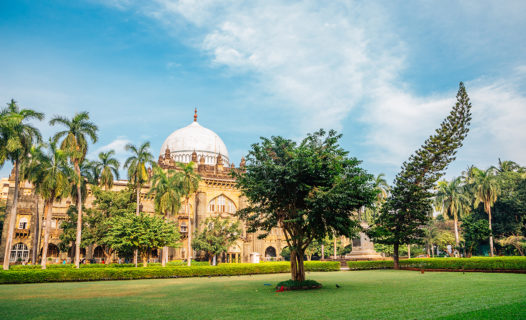
Discover 10 Fun Places to Visit in Mumbai with Friends
Discover the ultimate Mumbai adventure! Explore 10 fun-filled places to visit in Mumbai with friends and create unforgettable memories. Start your journey now!

Chill Out in Goa: Explore the Best Snow Park Experience
Discover the ultimate snow park experience in Goa! From thrilling rides to family fun, explore our guide and plan your perfect chill-out day.

Discover Where Sinulog Festival is Celebrated in Cebu!
Discover where the Sinulog Festival is celebrated in Cebu, Philippines! Join the vibrant festivities and immerse yourself in this unforgettable cultural experience.
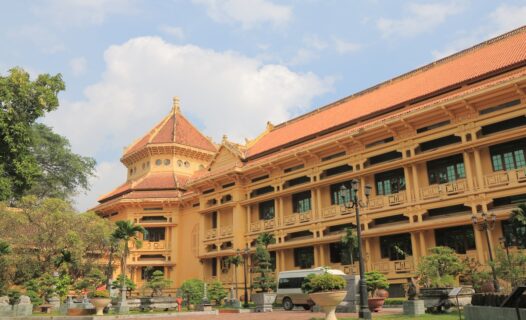
Discover Hanoi's Military History Museum: Fun & Adventure!
Discover the captivating tales at Hanoi's Military History Museum! Dive into a fun day of learning and adventure—plan your visit now!

Capture Lory Park Zoo Photos: Your Ultimate Johannesburg Guide
Capture unforgettable moments at Lory Park Zoo! Discover tips for stunning lory park zoo photos and make your Johannesburg adventure memorable. Click to learn more!

Discover Mumbai's Famous Places: Top 10 Epic Adventures
Discover Mumbai's famous places that promise an epic adventure! Explore our top 10 must-visit spots and start planning your unforgettable journey today!

The Aryavart Escape: Snap Stunning Panshet Photos in Pune
Discover the Aryavart Escape and capture stunning Panshet photos on your Pune getaway! Dive into our guide for tips and breathtaking spots. Start your adventure now!

Explore Hanoi's Train Street: Coffee & Scenic Journeys
Discover the charm of Hanoi's Train Street! Join us for a day of thrilling train sightings and delightful coffee sips. Click to explore this unique experience!

Swim with Sharks at Dubai Aquarium: An Unforgettable Adventure
Dive into adventure at the Dubai Aquarium! Discover the thrill of swimming with sharks and make unforgettable memories. Plan your visit today!
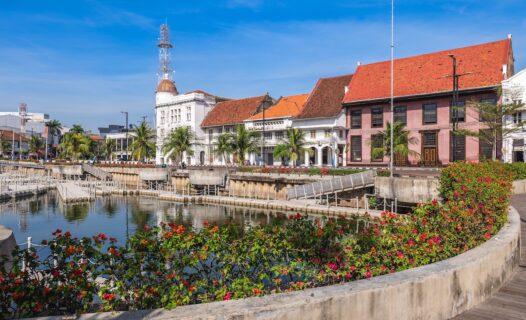
Central Jakarta: Discover Street Eats & Hidden Cafés
Discover Central Jakarta's vibrant food scene! Dive into street eats and hidden cafés that will tantalize your taste buds. Start your culinary adventure now!

Discover 10 Quirky Bangkok Things to Do That Will Make You Smile
Discover Bangkok's quirky side with 10 unusual things to do that will make you smile. Dive into the fun—explore now for a unique adventure!
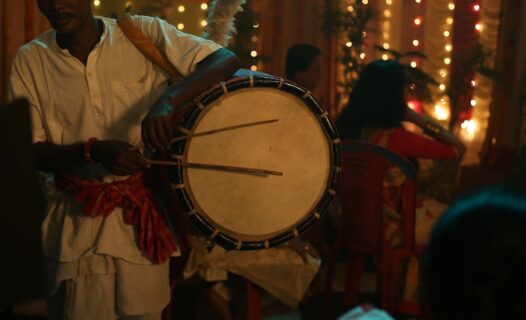
Kolkata to Digha Train: Your Ultimate Beach Adventure Guide
Embark on a thrilling train journey from Kolkata to Digha! Discover beach bliss and adventure. Read more to plan your perfect getaway today!



